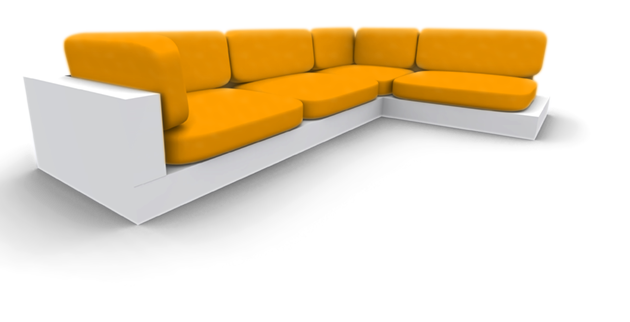| Autor |
Beitrag |
Phantom1
       
Beiträge: 390
|
Verfasst: Mi 03.12.03 16:52
Hi,
Ich habe eine Procedure geschrieben die ähnlich wie GaussianBlur arbeit, man kann sie aber auch fürs Soften/Blurren/AntiAliasing benutzten. Man kann einen Pixelradius angeben (von 0.0000001 bis 50 pixel). Je größer der Wert desto mehr wird geblurrt. (achtung große werte können sehr viel rechenzeit beanspruchen!)
Die Matrix und der divisor werden dabei ebenfalls automatisch berechnet, hier mal zwei beispiele zum besseren verständniss:
bei einem radius von 2,0
0,17|0,76|1,00|0,76|0,17
0,76|1,60|2,00|1,60|0,76
1,00|2,00| 3,00|2,00|1,00
0,76|1,60|2,00|1,60|0,76
0,17|0,76|1,00|0,76|0,17
und radius 3,6
0,00|0,00|0,13|0,48|0,60|0,48|0,13|0,00|0,00
0,00|0,36|0,99|1,40|1,60|1,40|0,99|0,36|0,00
0,13|0,99|1,80|2,40|2,60|2,40|1,80|0,99|0,13
0,48|1,40|2,40|3,20|3,60|3,20|2,40|1,40|0,48
0,60|1,60|2,60|3,60| 4,60|3,60|2,60|1,60|0,60
0,48|1,40|2,40|3,20|3,60|3,20|2,40|1,40|0,48
0,13|0,99|1,80|2,40|2,60|2,40|1,80|0,99|0,13
0,00|0,36|0,99|1,40|1,60|1,40|0,99|0,36|0,00
0,00|0,00|0,13|0,48|0,60|0,48|0,13|0,00|0,00
Desweiteren habe ich die procedure ebenfalls sogut ich konnte optimiert (ich kann allerdings kein assembler).
So und hier der sourcecode:
1:
2:
3:
4:
5:
6:
7:
8:
9:
10:
11:
12:
13:
14:
15:
16:
17:
18:
19:
20:
21:
22:
23:
24:
25:
26:
27:
28:
29:
30:
31:
32:
33:
34:
35:
36:
37:
38:
39:
40:
41:
42:
43:
44:
45:
46:
47:
48:
49:
50:
51:
52:
53:
54:
55:
56:
57:
58:
59:
60:
61:
62:
63:
64:
65:
66:
67:
68:
69:
70:
71:
72:
73:
74:
75:
76:
77:
78:
79:
| procedure BmpGBlur(Bmp: TBitmap; radius: Single);
Type
TRGB = Packed Record b, g, r: Byte End;
ArrTRGB = Array of TRGB;
ArrSingle = Array of Single;
Var
MatrixDim, MatrixRadius: Byte;
Matrix : Array of ArrSingle;
MatrixY : ^ArrSingle;
Faktor : ^Single;
BmpCopy : Array of ArrTRGB;
BmpCopyY : ^ArrTRGB;
BmpRGB, BmpCopyRGB: ^TRGB;
BmpWidth, BmpHeight, x, y, dx, dy: Integer;
StartDx, CountDx, StartDy, CountDy: Integer;
R, G, B, Divisor: Single;
Procedure CalculateMatrix;
Var x,y: Integer; MxRadius, f: Single;
Begin
radius:=radius+1; If Frac(radius)=0 Then MatrixDim:=Pred(Trunc(radius)*2) Else MatrixDim:=Succ(Trunc(radius)*2);
SetLength(Matrix,MatrixDim,MatrixDim);
MxRadius:=MatrixDim div 2;
For y:=0 To Pred(MatrixDim) Do
For x:=0 To Pred(MatrixDim) Do begin
f:=radius-Sqrt(Sqr(x-MxRadius)+Sqr(y-MxRadius));
If f<0 Then f:=0; Matrix[y,x]:=f;
end;
End;
Begin
Bmp.PixelFormat:=pf24bit;
If radius<=0 Then radius:=1 Else If radius>=50 Then radius:=50; CalculateMatrix;
BmpWidth:=Bmp.Width;
BmpHeight:=Bmp.Height;
SetLength(BmpCopy,BmpHeight,BmpWidth);
For y:=0 To Pred(BmpHeight) Do
Move(Bmp.ScanLine[y]^,BmpCopy[y,0],BmpWidth*3);
MatrixRadius:=Pred(MatrixDim) Div 2;
For y:=0 To Pred(BmpHeight) Do Begin
BmpRGB:=Bmp.ScanLine[y];
For x:=0 to Pred(BmpWidth) Do Begin
R:=0; G:=0; B:=0; Divisor:=0;
If y<MatrixRadius Then StartDy:=y Else StartDy:=MatrixRadius;
If y>Pred(BmpHeight)-MatrixRadius Then CountDy:=Pred(BmpHeight)-y+StartDy
Else CountDy:=MatrixRadius+StartDy;
If x<MatrixRadius Then StartDx:=x Else StartDx:=MatrixRadius;
If x>Pred(BmpWidth)-MatrixRadius Then CountDx:=Pred(BmpWidth)-x+StartDx
Else CountDx:=MatrixRadius+StartDx;
MatrixY:=@Matrix[MatrixRadius-StartDy];
BmpCopyY:=@BmpCopy[y-StartDy];
For dy:=0 To CountDy Do Begin
Faktor:=@MatrixY^[MatrixRadius-StartDx];
BmpCopyRGB:=@BmpCopyY^[x-StartDx];
For dx:=0 To CountDx Do Begin
B:=B+BmpCopyRGB^.b*Faktor^; G:=G+BmpCopyRGB^.g*Faktor^; R:=R+BmpCopyRGB^.r*Faktor^; Divisor:=Divisor+Faktor^;
Inc(BmpCopyRGB);
Inc(Faktor);
End;
Inc(MatrixY);
Inc(BmpCopyY);
End;
BmpRGB.b:=Round(B/Divisor);
BmpRGB.g:=Round(G/Divisor);
BmpRGB.r:=Round(R/Divisor);
Inc(BmpRGB);
End;
End;
End; |
|
|
obbschtkuche
Gast
Erhaltene Danke: 1
|
Verfasst: Mi 03.12.03 17:22
Hier habe ich noch eine procedure die das Selbe macht (habe ich irgendwann mal gefunden ;)) allerdings ist sie ein wenig schneller und blurt bei halbem Radius mit gleicher Stärke.
1:
2:
3:
4:
5:
6:
7:
8:
9:
10:
11:
12:
13:
14:
15:
16:
17:
18:
19:
20:
21:
22:
23:
24:
25:
26:
27:
28:
29:
30:
31:
32:
33:
34:
35:
36:
37:
38:
39:
40:
41:
42:
43:
44:
45:
46:
47:
48:
49:
50:
51:
52:
53:
54:
55:
56:
57:
58:
59:
60:
61:
62:
63:
64:
65:
66:
67:
68:
69:
70:
71:
72:
73:
74:
75:
76:
77:
78:
79:
80:
81:
82:
83:
84:
85:
86:
87:
88:
89:
90:
91:
92:
93:
94:
95:
96:
97:
98:
99:
100:
101:
102:
103:
104:
105:
106:
107:
108:
109:
110:
111:
112:
113:
114:
115:
116:
117:
118:
119:
120:
121:
122:
123:
124:
125:
126:
127:
128:
129:
130:
131:
132:
133:
134:
135:
136:
137:
138:
139:
140:
141:
142:
| unit gblur;
interface
uses Graphics, SysUtils;
const MaxKernelSize = 100;
type
PRGBTriple = ^TRGBTriple;
TRGBTriple = packed record
b: byte; g: byte;
r: byte;
end;
PRow = ^TRow;
TRow = array[0..1000000] of TRGBTriple;
PPRows = ^TPRows;
TPRows = array[0..1000000] of PRow;
TKernelSize = 1..MaxKernelSize;
TKernel = record
Size: TKernelSize;
Weights: array[-MaxKernelSize..MaxKernelSize] of single;
end;
procedure GaussianBlur(theBitmap: TBitmap; radius: double);
implementation
procedure MakeGaussianKernel(var K: TKernel; radius: double;
MaxData, DataGranularity: double);
var j: integer; temp, delta: double; KernelSize: TKernelSize;
begin
for j:= Low(K.Weights) to High(K.Weights) do
begin
temp:= j/radius;
K.Weights[j]:= exp(- temp*temp/2);
end;
temp:= 0;
for j:= Low(K.Weights) to High(K.Weights) do
temp:= temp + K.Weights[j];
for j:= Low(K.Weights) to High(K.Weights) do
K.Weights[j]:= K.Weights[j] / temp;
KernelSize:= MaxKernelSize;
delta:= DataGranularity / (2*MaxData);
temp:= 0;
while (temp < delta) and (KernelSize > 1) do
begin
temp:= temp + 2 * K.Weights[KernelSize];
dec(KernelSize);
end;
K.Size:= KernelSize;
temp:= 0;
for j:= -K.Size to K.Size do
temp:= temp + K.Weights[j];
for j:= -K.Size to K.Size do
K.Weights[j]:= K.Weights[j] / temp;
end;
function TrimInt(Lower, Upper, theInteger: integer): integer;
begin
if (theInteger <= Upper) and (theInteger >= Lower) then
result:= theInteger
else
if theInteger > Upper then result := Upper
else result := Lower;
end;
function TrimReal(Lower, Upper: integer; x: double): integer;
begin
if (x < upper) and (x >= lower) then
result:= trunc(x)
else
if x > Upper then
result:= Upper
else
result:= Lower;
end;
procedure BlurRow(var theRow: array of TRGBTriple; K: TKernel; P: PRow);
var
j, n, LocalRow: integer;
tr, tg, tb: double;
w: double;
begin
for j:= 0 to High(theRow) do
begin
tb:= 0;
tg:= 0;
tr:= 0;
for n:= -K.Size to K.Size do
begin
w:= K.Weights[n];
with theRow[TrimInt(0, High(theRow), j - n)] do
begin
tb:= tb + w * b;
tg:= tg + w * g;
tr:= tr + w * r;
end;
end;
with P[j] do
begin
b:= TrimReal(0, 255, tb);
g:= TrimReal(0, 255, tg);
r:= TrimReal(0, 255, tr);
end;
end;
Move(P[0], theRow[0], (High(theRow) + 1) * Sizeof(TRGBTriple));
end;
procedure GaussianBlur(theBitmap: TBitmap; radius: double);
var
Row, Col: integer;
theRows: PPRows;
K: TKernel;
ACol, P: PRow;
begin
if (theBitmap.HandleType <> bmDIB) or (theBitmap.PixelFormat <> pf24Bit) then
raise exception.Create('GBlur only works for 24-bit bitmaps');
MakeGaussianKernel(K, radius, 255, 1);
GetMem(theRows, theBitmap.Height * SizeOf(PRow));
GetMem(ACol, theBitmap.Height * SizeOf(TRGBTriple));
for Row:= 0 to theBitmap.Height - 1 do
theRows[Row]:= theBitmap.Scanline[Row];
P:= AllocMem(theBitmap.Width*SizeOf(TRGBTriple));
for Row:= 0 to theBitmap.Height - 1 do
BlurRow(Slice(theRows[Row]^, theBitmap.Width), K, P);
ReAllocMem(P, theBitmap.Height*SizeOf(TRGBTriple));
for Col:= 0 to theBitmap.Width - 1 do
begin
for Row:= 0 to theBitmap.Height - 1 do
ACol[Row]:= theRows[Row][Col];
BlurRow(Slice(ACol^, theBitmap.Height), K, P);
for Row:= 0 to theBitmap.Height - 1 do
theRows[Row][Col]:= ACol[Row];
end;
FreeMem(theRows);
FreeMem(ACol);
ReAllocMem(P, 0);
end;
end. |
|
|
Phantom1 
       
Beiträge: 390
|
Verfasst: Mi 03.12.03 19:11
hi obbschtkuche,
habs eben mal getestet, bei einen radius von 3 bei meiner procedure und radius von 1.5 bei dem von dir geposteten procedure ist blurfaktor und die geschwindigkeit fast gleich! bei niedrigeren radien ist dagegen meine wesentlich schneller und bei höheren die andere procedure. Ich glaube das liegt daran das ich eine dynamische matrix verwende und die andere eine feste hat.
|
|
obbschtkuche
Gast
Erhaltene Danke: 1
|
Verfasst: Mi 03.12.03 19:22
sorry, ich habs nur mit 10 getestet. Also am besten beide verwenden, nur eben die eine für Große radien und die andere für kleine ;)
|
|
Phantom1 
       
Beiträge: 390
|
Verfasst: Mi 03.12.03 20:18
desweiteren produziert die von dir gepostete procedure bei radien unter 0.5 ziemlich viele pixelfehler :-/
naja mal sehen ich werde meine procedure auch noch weiter verbessern und vieleicht kann ich ein paar ideen von deiner procedure mit einbauen 
|
|
Phantom1 
       
Beiträge: 390
|
Verfasst: Do 04.12.03 13:27
So habe meine procedure nochmal komplett überarbeitet. Die procedure ist jetzt etwa doppelt so schnell wie die beiden bisher geposteten proceduren zusammen !!!! Pixelfehler gibts bei mir auch nicht.
Hier der Code:
1:
2:
3:
4:
5:
6:
7:
8:
9:
10:
11:
12:
13:
14:
15:
16:
17:
18:
19:
20:
21:
22:
23:
24:
25:
26:
27:
28:
29:
30:
31:
32:
33:
34:
35:
36:
37:
38:
39:
40:
41:
42:
43:
44:
45:
46:
47:
48:
49:
50:
51:
52:
53:
54:
55:
56:
57:
58:
59:
60:
61:
62:
63:
64:
65:
66:
67:
68:
69:
70:
71:
72:
73:
74:
75:
76:
77:
78:
79:
80:
81:
82:
83:
84:
85:
| procedure TForm1.BmpGBlur(Bmp: TBitmap; radius: Single);
Type
TRGB = Packed Record b, g, r: Byte End;
TRGBs = Packed Record b, g, r: Single End;
TRGBArray = Array[0..0] of TRGB;
Var
MatrixRadius: Byte;
Matrix : Array[-100..100] of Single;
Procedure CalculateMatrix;
Var x: Integer; Divisor: Single;
Begin
radius:=radius+1; MatrixRadius:=Trunc(radius);
If Frac(radius)=0 Then Dec(MatrixRadius);
Divisor:=0;
For x:=-MatrixRadius To MatrixRadius Do Begin
Matrix[x]:=radius-abs(x);
Divisor:=Divisor+Matrix[x];
End;
For x:=-MatrixRadius To MatrixRadius Do
Matrix[x]:=Matrix[x]/Divisor;
End;
Var
BmpSL : ^TRGBArray;
BmpRGB : ^TRGB;
BmpCopy : Array of Array of TRGBs;
BmpCopyRGB : ^TRGBs;
R, G, B : Single;
BmpWidth, BmpHeight: Integer;
x, y, mx : Integer;
Begin
Bmp.PixelFormat:=pf24bit;
If radius<=0 Then radius:=1 Else If radius>99 Then radius:=99; CalculateMatrix;
BmpWidth:=Bmp.Width;
BmpHeight:=Bmp.Height;
SetLength(BmpCopy,BmpHeight,BmpWidth);
For y:=0 To Pred(BmpHeight) Do Begin
BmpSL:=Bmp.Scanline[y];
BmpCopyRGB:=@BmpCopy[y,0];
For x:=0 to Pred(BmpWidth) Do Begin
R:=0; G:=0; B:=0;
For Mx:=-MatrixRadius To MatrixRadius Do Begin
If x+mx<0 Then
BmpRGB:=@BmpSL^[0] Else If x+mx>=BmpWidth Then
BmpRGB:=@BmpSL^[Pred(BmpWidth)] Else
BmpRGB:=@BmpSL^[x+mx];
B:=B+BmpRGB^.b*Matrix[mx];
G:=G+BmpRGB^.g*Matrix[mx];
R:=R+BmpRGB^.r*Matrix[mx];
End;
BmpCopyRGB^.b:=B; BmpCopyRGB^.g:=G;
BmpCopyRGB^.r:=R;
Inc(BmpCopyRGB);
End;
End;
For y:=0 To Pred(BmpHeight) Do Begin
BmpRGB:=Bmp.ScanLine[y];
For x:=0 to Pred(BmpWidth) Do Begin
R:=0; G:=0; B:=0;
For mx:=-MatrixRadius To MatrixRadius Do Begin
If y+mx<=0 Then
BmpCopyRGB:=@BmpCopy[0,x] Else If y+mx>=BmpHeight Then
BmpCopyRGB:=@BmpCopy[Pred(BmpHeight),x] Else
BmpCopyRGB:=@BmpCopy[y+mx,x];
B:=B+BmpCopyRGB^.b*Matrix[mx];
G:=G+BmpCopyRGB^.g*Matrix[mx];
R:=R+BmpCopyRGB^.r*Matrix[mx];
End;
BmpRGB^.b:=Round(B);
BmpRGB^.g:=Round(G);
BmpRGB^.r:=Round(R);
Inc(BmpRGB);
End;
End;
End; |
|
|
|














































![Antworten [gesperrt]](./graphics/navbar/reply.png)






